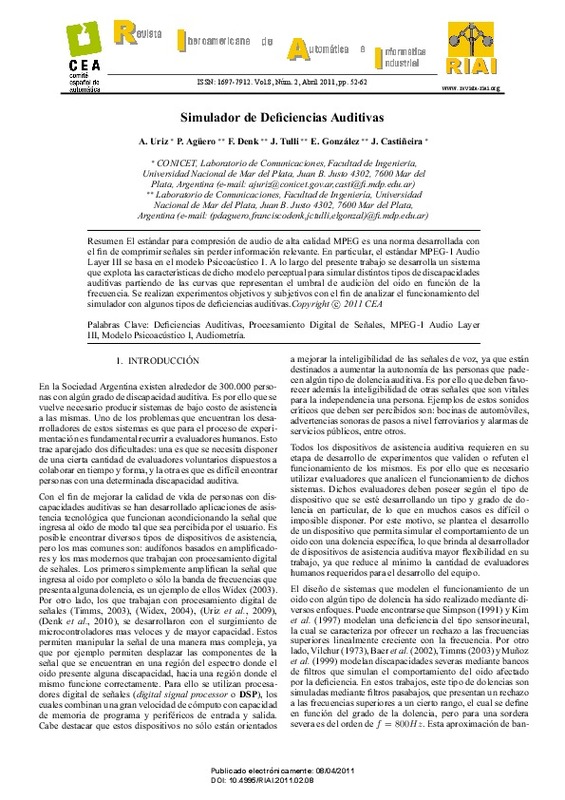JavaScript is disabled for your browser. Some features of this site may not work without it.
Buscar en RiuNet
Listar
Mi cuenta
Estadísticas
Ayuda RiuNet
Admin. UPV
Simulador de Deficiencias Auditivas
Mostrar el registro sencillo del ítem
Ficheros en el ítem
| dc.contributor.author | Uriz, A.
|
es_ES |
| dc.contributor.author | Agüero, P.
|
es_ES |
| dc.contributor.author | Denk, F.
|
es_ES |
| dc.contributor.author | Tulli, J.
|
es_ES |
| dc.contributor.author | González, E.
|
es_ES |
| dc.contributor.author | Castiñeira, J.
|
es_ES |
| dc.date.accessioned | 2020-05-28T15:35:16Z | |
| dc.date.available | 2020-05-28T15:35:16Z | |
| dc.date.issued | 2011-04-08 | |
| dc.identifier.issn | 1697-7912 | |
| dc.identifier.uri | http://hdl.handle.net/10251/144525 | |
| dc.description.abstract | [EN] The audio compression standard for high-quality MPEG is a standard developed to compress signals without losing relevant information. In particular, the MPEG-1 Audio Layer III is based on Psychoacoustic Model I. Throughout this paper a system that exploits the characteristics of the perceptual model to simulate different types of hearing impairment based on the curves representing the threshold of hearing of the ear as a function of frequency. Subjective and objective experiments are made in order to analyze the performance of the simulator with some types of hearing impairment. | es_ES |
| dc.description.abstract | [ES] El estándar para compresión de audio de alta calidad MPEG es una norma desarrollada con el fin de comprimir señales sin perder información relevante. En particular, el estándar MPEG-1 Audio Layer III se basa en el modelo Psicoacústico I. A lo largo del presente trabajo se desarrolla un sistema que explota las características de dicho modelo perceptual para simular distintos tipos de discapacidades auditivas partiendo de las curvas que representan el umbral de audición del oido en función de la frecuencia. Se realizan experimentos objetivos y subjetivos con el fin de analizar el funcionamiento del simulador con algunos tipos de deficiencias auditivas. | es_ES |
| dc.language | Español | es_ES |
| dc.publisher | Universitat Politècnica de València | es_ES |
| dc.relation.ispartof | Revista Iberoamericana de Automática e Informática industrial | es_ES |
| dc.rights | Reconocimiento - No comercial - Sin obra derivada (by-nc-nd) | es_ES |
| dc.subject | Hearing Impairments | es_ES |
| dc.subject | Digital Signal Processing | es_ES |
| dc.subject | MPEG-1 Audio Layer III | es_ES |
| dc.subject | Psychoacoustic Model I | es_ES |
| dc.subject | Audiometry | es_ES |
| dc.subject | Deficiencias Auditivas | es_ES |
| dc.subject | Procesamiento Digital de Señales | es_ES |
| dc.subject | Modelo Psicoacústico I | es_ES |
| dc.subject | Audiometría | es_ES |
| dc.title | Simulador de Deficiencias Auditivas | es_ES |
| dc.title.alternative | Hearing Impairment Simulator | es_ES |
| dc.type | Artículo | es_ES |
| dc.identifier.doi | 10.1016/S1697-7912(11)70026-7 | |
| dc.rights.accessRights | Abierto | es_ES |
| dc.description.bibliographicCitation | Uriz, A.; Agüero, P.; Denk, F.; Tulli, J.; González, E.; Castiñeira, J. (2011). Simulador de Deficiencias Auditivas. Revista Iberoamericana de Automática e Informática industrial. 8(2):52-62. https://doi.org/10.1016/S1697-7912(11)70026-7 | es_ES |
| dc.description.accrualMethod | OJS | es_ES |
| dc.relation.publisherversion | https://doi.org/10.1016/S1697-7912(11)70026-7 | es_ES |
| dc.description.upvformatpinicio | 52 | es_ES |
| dc.description.upvformatpfin | 62 | es_ES |
| dc.type.version | info:eu-repo/semantics/publishedVersion | es_ES |
| dc.description.volume | 8 | es_ES |
| dc.description.issue | 2 | es_ES |
| dc.identifier.eissn | 1697-7920 | |
| dc.relation.pasarela | OJS\8575 | es_ES |
| dc.description.references | Baer, T., Moore, B. C. J., & Kluk, K. (2002). Effects of low pass filtering on the intelligibility of speech in noise for people with and without dead regions at high frequencies. The Journal of the Acoustical Society of America, 112(3), 1133-1144. doi:10.1121/1.1498853 | es_ES |
| dc.description.references | Fletcher, H. (1940). Auditory Patterns. Reviews of Modern Physics, 12(1), 47-65. doi:10.1103/revmodphys.12.47 | es_ES |
| dc.description.references | ISO (1994). International Organization of Standardization ISO/IEC JTC1/SC29/WG111 MPEG IS13813(1994): Generic Coding of Moving Pictures and Associated Audio. International Organization of Standardization. Ginebra, Suiza. | es_ES |
| dc.description.references | ITU-T, International Telecomunication Union, Ed.) (2003). Series P: Telephone Quality, Telephone Installations, Local Line Networks: Methods for objective and subjective assessment of quality. International Telecomunication Union. Ginebra, Suiza. | es_ES |
| dc.description.references | Maniwa, K., Jongman, A., & Wade, T. (2008). Perception of clear fricatives by normal-hearing and simulated hearing-impaired listeners. The Journal of the Acoustical Society of America, 123(2), 1114-1125. doi:10.1121/1.2821966 | es_ES |
| dc.description.references | Paarmann, L. D., Wynne, M. K., Pugh, C. M., & Bi, J. (1994). Bimodal perception of spectrum compressed speech. The Journal of the Acoustical Society of America, 95(5), 2975-2976. doi:10.1121/1.408980 | es_ES |
| dc.description.references | Slaney, M. (1998). Auditory toolbox. Technical Report 010. Palo Alto, Estados Unidos de America. | es_ES |
| dc.description.references | Timms, O. (2003). Speech Processing strategies based on the sinusoidal speech model for the profoundly Hearing Impaired, Ph.D. Thesis. Tech Wissenschaften ETH. Zurich, Suiza. | es_ES |
| dc.description.references | Villchur, E. (1973). Signal processing to improve speech intelligibility in perceptive deafness. The Journal of the Acoustical Society of America, 53(6), 1646-1657. doi:10.1121/1.1913514 | es_ES |
| dc.description.references | Widex (2003). Manual técnico del dispositivo bravo. | es_ES |
| dc.description.references | Widex (2004). Manual técnico del dispositivo senso plus sic. | es_ES |
| dc.description.references | Zwicker, E., Flottorp, G., & Stevens, S. S. (1957). Critical Band Width in Loudness Summation. The Journal of the Acoustical Society of America, 29(5), 548-557. doi:10.1121/1.1908963 | es_ES |








